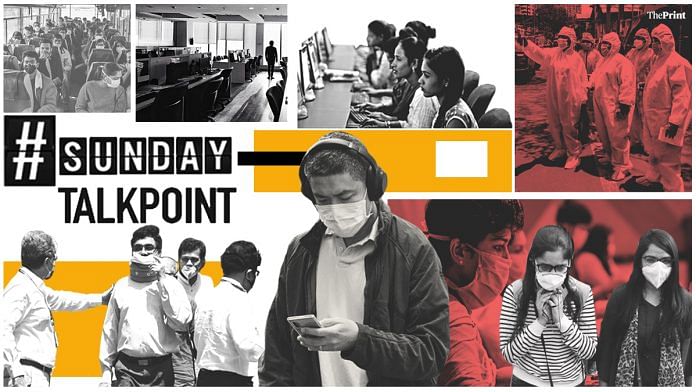Experts say that herd immunity, a controversial strategy discarded by the UK, is the solution for developing and demographically young countries like India to fight the coronavirus pandemic. The strategy calls for the majority of a population to gain resistance to the virus by becoming infected and then recovering.
ThePrint asks: Should young people be encouraged to go back to work faster to build herd immunity?
Young Indians going out will expose older parents at home to greater Covid-19 risk
 Mohana Basu
Mohana Basu
Special correspondent, ThePrint
Statistically speaking, the odds of younger people dying from Covid-19 are much lower. Most young people do not experience severe symptoms, and recover from the disease on their own, experts say. But just because people around the world are dying by the thousands, it does not mean that we start treating a few hundred people as expendable for the greater good.
It is not that people below 60 are not dying at all from the infection. And each and every death is a tragedy for a family. Moreover, unlike in the West, many young Indians live in close-knit joint families. The young people go back home to older parents, and grandparents, who will be at significant risk.
This idea, that we let a disease run its course to achieve herd immunity, does not make sense for a country of over one billion people. Lower odds may still translate to thousands of deaths. The ethical way of achieving herd immunity is by developing a vaccine. Until then, each and every life must be protected through whatever mitigation measures are available to us.
Many young Indians have diabetes, high blood pressure. These conditions should be considered before controversial decision
 Himani Chandna
Himani Chandna
Special correspondent, ThePrint
To attain herd immunity, the country has to bet on its young population. Data says about 50 per cent of India’s population is under the age of 25, while about 65 per cent is under 35 years.
Send them out to work. Let them acquire infection, develop antibodies, recover and become resistant. Soon, at least 60 per cent of the population will become resistant, breaking the chain of transmission and, hence, save the lives of older people and those with comorbidities.
Let us do some data-crunching. One in every four Indian youngsters suffers from type-2 diabetes while youngsters under the age of 25 are increasingly at the risk of acquiring the diseases. One in every five Indian young adults has high blood pressure. Reports indicate that heart attacks are on the rise among 30-40-year-olds. India carries the highest burden of anaemia. We should factor in these comorbid conditions before developing the game plan.
The world is watching Sweden, which claims to have almost reached “herd immunity” in Stockholm. But we are different. Apart from our population difference (Sweden has one crore people and India, 130 crore), the working adults in Sweden typically stay away from their parents.
In India, the majority of working adults come back home every evening to their elderly parents. They might end up infecting the parents. The concept is controversial and the public health system needs to play on the front foot. It should be prepared for a massive spike in the number of cases, capability to increase testing phenomenally, and, of course, a plan-B.
Allowing youth to go to work will lessen economic burden of lockdown and help build immunity
 Bismee Taskin
Bismee Taskin
Reporter, ThePrint
Yes, young people should definitely be encouraged and allowed to go back to work to build herd immunity. Here, one must understand that, with no vaccine yet, there is no guarantee of immunity. India. however, cannot afford to keep extending lockdown.
For an economy like India, the only solution now to save both lives and livelihoods is herd immunity. Life has to roll back soon to normalcy.
Herd immunity, I feel, should be the most important point for a calibrated exit. It will allow the majority of the population to gain resistance against the virus. One of India’s top epidemiologists, Dr Jayaprakash Muliyil, has noted that the coronavirus can thrive in a population as long as a part of it is susceptible to the virus, and as more people get infected, immunity builds up in the community. Moreover, researchers at Princeton University and the Centre for Disease Dynamics, Economics and Policy have also identified India as a country where herd immunity could work.
Union health ministry data shows that the majority of Covid-19 deaths in India are among people aged above 60 years. Therefore, allowing youth to go to work will lessen the economic burden of the lockdown and help build immunity. Also, young people are responsible, and will follow social distancing and hygiene guidelines when back at home after work, even if they are in proximity to the elderly of the family.
Not feasible to reopen India along boundaries the virus does not respect
 Sandhya Ramesh
Sandhya Ramesh
Senior assistant editor, ThePrint
Opening up a country based on age groups rather than the essentiality of a group or business is highly risky, especially for overcrowded India.
If the younger population of the Indian workforce has to go back to work, the work burden would be disproportionate. And without schools opening, younger India would depend on older parents, grandparents, or domestic workers for childcare.
A lot of young urban India is very much dependent on domestic assistance already as they work impossible hours every day, and across socioeconomic strata. Conversely, the older population often requires and survives because of care labour from the younger population.
Indian families are still large, where parents live with their children, their spouses and grandchildren. Not only are there societal expectations on the younger generation, there also is a lack of space to actually keep people separated along age lines for extended periods of time. This would further add to the emotional trauma at a time when everyone feels safe at home.
It is not feasible to reopen the country along boundaries the virus does not respect.
Young Indians must go back to work under controlled conditions, need to adjust to a post-Covid world
 Swagata Yadavar
Swagata Yadavar
Assistant editor, ThePrint
Countries cannot be in a state of lockdown forever. We are already seeing the economic ramifications of the Covid-19 lockdown and we need to start thinking of getting back to work, but under controlled conditions. Experts have said young Indians, who are less vulnerable to facing Covid-related complications, should be the first to go out. All those who are above 60 years of age or with weaker immunity need to stay home until the country achieves herd immunity.
Things can’t go back to normal — we will need to adjust to a post-Covid world. Considering the old and young live together in Indian families, we would need to find solutions to separate them inside the house.
Also, those who are sent back to work should first be screened for diabetes, hypertension, kidney disease or other conditions. We need to provide them with free healthcare and health insurance.
Public transport, health infrastructure will need to be redesigned to have ample space for physical distancing. We would have to change the way we socialise — no live concerts, no big weddings, probably. Maybe a year of this kind of social distancing will mean enough of us develop antibodies to the virus and it will no longer pose the threat that it does now.
Also read: Will more people turn to vegetarianism in a post-coronavirus world?
By Pia Krishnankutty, journalist at ThePrint







This discussion between The Prints’s writers is devoid of any understanding of herd immunity.
To say a population has herd immunity at least 70% need to be resistant.
Without a vaccine or at a minimum an effective anti-viral no country is ready to go back to pre-C19 practices .
Removing physical distancing norms is a prescription for disaster- case in point Sweden’s effort to build herd immunity.
Herd immunity should not be viewed as an aim to be achieved; it should be more of a consequence of actions which have to be necessarily taken at this stage to keep the economy moving towards recovery and progress.
Here the individuals (each Indian) should take the responsibility for his safety and for the safety of those he comes in contact – guidelines like social distancing, hygiene, masks, hand washing etc. are all well known to all.
Thinking out of the box and temporary hardships are inevitable (3 to 6 months). For instance – Yes, there is a problem where most Indian houses are a bit small for a home. Methods may have to be devised within communities to segregate the non-working vulnerable people.
It is not only the Governments, people will also have to come up with ideas – ther is just nor solution, where one size will fit all…
Unless we are digging in for a very long lockdown, this untested theory does not commend itself for adoption in India. The young will almost certainly bring the virus home, exposing their older family members to risk. With 80% cases asymptomatic, transmission would take place unnoticed within families. A better approach would be to open up the country geographically, with cities like Bombay among the last places to exit the lockdown. It is almost certain now that some climatic / genetic / other natural factors – not lighting candles, though – are helping us stand up to the virus.